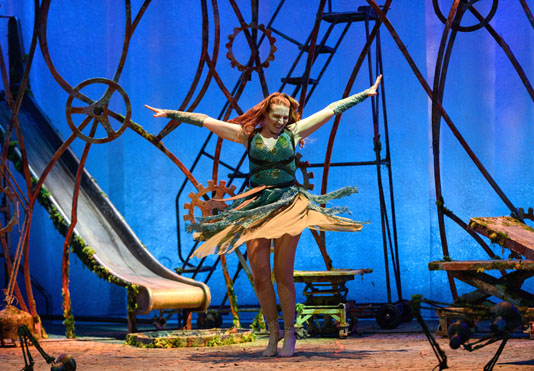
We are fortunate that Francesco Cavalli’s La Calisto has survived to the modern day. It is an intriguing work that weaves together two separate tales from Greek mythology. One story is that of shepherd boy Endimione’s innocent love for Diana, goddess of the moon hunt; the other concerns Giove’s seduction of the virgin Calisto, which he achieves by disguising himself as Diana. When premiered in Venice in 1651 it attracted little attention, lasting for a mere eleven performances. Ominously, librettist Giovanni Faustini died during this brief run, and the opera lay largely forgotten for three centuries until it was revived at Glyndebourne in the 1970s.
English Touring Opera’s La Calisto is blessed with excellent singing in all the major roles, but director Timothy Nelson’s interpretation is too heavily weighted with symbolism. The central theme of this opera is surely an examination of the qualitative differences between carnal desire and spiritual love, but in this production that theme plays second fiddle to the debate between rational thought and spiritual faith. There is no doubt that Cavalli’s Endimione is more astronomer than shepherd boy, and we are undoubtedly meant to see echoes of Galileo’s fraught relationship with Rome in his character. However, Nelson is not content with Cavalli’s subtle hints, and in his determination to stress the idea that Endimione represents the principle of scientific enquiry he has transformed him into a comic version of Einstein, squinting through his thick spectacles as he busily chalks equations on a blackboard. This renders his relationship with Diana hard to swallow.
Much of the comedy is similarly heavy-handed, and some of the stage business depicting carnal lust is clichéd and crude. There is generally too much stage business throughout, and too often it acts as a distraction from the music, particularly in the first two acts. That is a pity, for the music is very fine indeed. Timothy Nelson is both director and conductor, and he draws excellent performances from both the orchestra and the cast. Paula Sides is a delightful, feisty Calisto, splashing playfully in the spring that Giove creates to entrap her. Her aria expressing her sorrow at being expelled from the forest is beautifully sung, and it is a rare moment when the singing is given space enough to become the centre of attention, free from distraction. Baritone George Humphries is a self-assured Giove, full of casual authority. When disguised as Diana he becomes a balloon-chested pantomime dame, revealing a wonderfully full-bloodied falsetto. His sidekick Mercurio is sung by Nick Pritchard, whose twinkly costume and camp gestures contrast with the macho swagger of his boss.
Catherine Carby is in excellent voice as Diana, and her chaste parting from Tai Oney’s Endimione is a vocal highlight. Oney is a fine countertenor, but he struggles to bring conviction to the wild-haired, violin-wielding caricature he has been asked to play. Another bizarre transformation involves Diana’s husband-hunting nymph Linfea. This is written as a soprano role, but here it has been given to tenor Adrian Dwyer, which adds a further unnecessary cross-dressing element to a production that is all-too eager take every opportunity to depict sexual ambiguity.
Takis has created a stage design featuring an attractive background of curving tree-like shapes bedecked with cogs and wheels. But elsewhere there is too much clutter. At times the cast appear to have difficulty picking their way through the maze of huge Anglepoise lamps and hydraulic platforms. The playground slide down which the gods descend to Earth is initially amusing, though the joke wears thin on repetition, and the squeaking of the castors on the platforms occasionally distracts from the singing. These are the only moments when the words become lost, for all the cast sing with great clarity of diction. Though there are surtitles they are not of the line-by-line kind, giving only brief plot summations, but this is entirely adequate.
There is much to admire in this production, but too often the music has not been allowed to speak for itself. However, the third and final act, beautifully lit by Mark Howland, is visually very effective and brings a welcome shift in tone. As Calisto ascends to the heavens to take her place among the stars, the cogs and wheels become bright constellations in the night sky. The mood is both solemn and serene, and the music is glorious. ★★★☆☆ Mike Whitton 25th October 2016
Photograph © Jane Hobson

